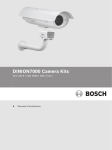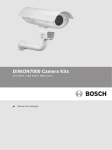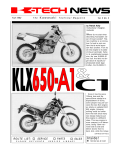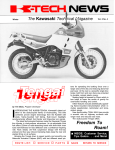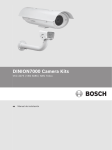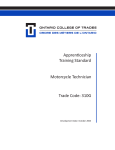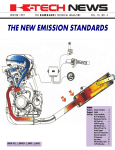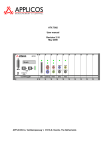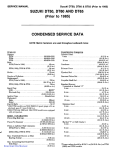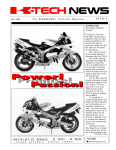Download K-Tech News Vol.7 No.3
Transcript
Fall 1994 The Kawasaki Technical Magazine The sensational VN800 Vulcan is one of three new models highlighting Kawasaki’s exciting ’95 motorcycle lineup. Vol. 7 No. 3 by Patrick Kelly Instructional Designer/ Instructor Where does one begin in a discussion of new Kawasaki motorcycles for 1995? There are three completely new models for ’95, each one unique and exciting ... The ZX-6R NEW PRODUCTS ’95 watercraft: Storm warning! Kawasaki’s new fleet of watercraft is set to take the industry by storm! Our commitment to being the industry leader is confirmed with the introduction of not just one, but four new watercraft for 1995. At the top of the line up is the awesome new, benchmark-setting, 900 ZXi. This new machine is powered by a 900cc three-cylinder, two-stroke engine-and we all know about Kawasaki’s reputation for incredible 900cc engines and two-stroke triples! The 900 ZXi, officially labeled the JH900-A1, is completely new from stem to stern and takes Kawasaki watercraft to the next level of development. The boat features a new hull, designed for great maneuverability and stability, combined with a new powertrain, which is highlighted by the new 900cc triplecylinder engine. This smooth engine is all new and does not share critical dimensions or components with any of our other watercraft CONTlNUED ON PAGE 3 If you are interested in the latest high-tech street weapon, the discussion would have to begin with the all-new ZX-6R, a rolling showcase for all of Kawasaki’s latest twowheel technology. The engine in the new ZX600-F1 is all-new and is more compact and much lighter than its predecessor. And, even more incredible, it is more powerful too! This was accomplished with a number of significant changes, the most obvious of which is a switch from driving the cams from the center of the crankshaft to driving the cams from the righthand end of the crankshaft. This makes the crankshaft shorter and more rigid, and also allows the intake and exhaust ports to be as straight as possible. Other new engine features include a cylinder that is canted farther forward than before; a steeper downdraft angle for the intake ports; larger diameter valves; revised camshaft timing; and an all-new clutch and transmission. CONTINUED ON PAGE 2 ROUTE LIST: o SERVICE o PARTS o SALES P L E A S ER E T U R NT OS E R V I C EL I B R A R Y Inside! n Service tips & more! ’95: Three for the road CONTINUED FROM PAGE 1 The ZX-6R’s chassis is an equal to its state-ofthe-art engine. Its rigid aluminum frame, steep 24° rake, 87mm trail and short 55.7in. wheelbase assure quick, responsive handling. A conventional cartridge front fork, adjustable for compression damping, rebound damping and spring preload handles the suspension chores up front while a Uni-Trak rear suspension, adjustable for compression damping, rebound damping, spring preload and ride height, handles the rear. No discussion of the new ZX-6R would be complete without mentioning its weight (or lack thereof): The ZX-6R is nearly 40lbs lighter than the ZX600-E! The VN800 But maybe your interest: lean towards the laid-back, bad-to-the-bone cruiser scene. In that case, discussion about Kawasaki’s ’95 models would certainly center on the all-new Vulcan 800. This is the latest generation of Kawasaki cruiser and is styled in the classically American tradition. Firepower for the new VN800-A1 is provided by an all-new 55° V-twin engine. In keeping with Sensational new ZX-6R (ABOVE) is 40lbs lighter than the ZX600-E. The similarly all-new Vulcan 800 (BELOW) also breaks new ground in the high-technology department. 2 l K-Tech News GPz 1100: Sport orientation with all-day riding comfort. the theme of “simple is better,” the engine is fed by a single 36mm CDK carburetor with an accelerator pump. The air filter can be accessed by removing just one bolt and the whole carburetor by removing just two more boIts. The engine does benefit from liquid cooling even though, at first glance (and maybe second), it appears to be air-cooled. Careful examination reveals a radiator carefully nestled between the frame downtubes; radiator hoses are hidden too, helping the VN retain that classic air-cooled look. A gear-driven counterbalancer and rubber engine mounts make this modern V-twin smooth. Single overhead cams open four valves per cylinder, making sure that the VN800 goes as well as it shows. The VN’s chassis features a wide Showa front fork, a unique UniTrak rear suspension with I hard-tail look, a 21-inch front tire and 16-inch rear tire. Both wheels are spoked, in keeping with the classic styling. The speedometer rests on the fuel tank and is cable-driven off of the rear wheel, helping to keep the front end clean and uncluttered. The GPz 1100 But let’s say that, for ’95, you are interested in a powerful, versatile sporting machine at an economical price. Then the new Kawasaki GPz 1100 would definitely enter the conversation here. The engine in the ZX1100-E1 is based on the legendary ZX-11 engine, with a few changes to smooth out its incredible power delivery. It features a new cylinder head with sidedraft intake ports mounting smaller CDK 36mm carburetors. Camshafts with 10° less duration and a new 4-into-2 exhaust system complete the engine’s transformation. The chassis is based on an economical onepiece, double-cradle steel frame and steel swingarm. A sturdy 41 mm front fork graces the front end while a Uni-Trak system with an adjustable rear shock supports the rear. The riding position and fairing are sport-oriented but still designed for all-day comfort. So, no matter what kind of street bike sparks your interests, Kawasaki’s ’95 lineup is sure to give you and your fellow enthusiasts something to talk about. o ’95 Watercraft CONTlNUED FROM PAGE 1 engines. With three Keihin CDK38 carburetors, a completely waterjacketed exhaust system and many other interesting new design features, the new 900 produces a whopping 100 hp. The powertrain is completed by an all-new jet pump with a three-blade, stainless steel impeller for a maximum thrust of 732 pounds. The ZXi also features electrically adjustable trim, tachometer, speed- ometer and fuel gauge, trim indicator and a new trigger-type throttle. The new 750 ZXi is the 900 ZXi’s little brother and features the same basic hull design. It is powered by a revised version of Kawasaki’s dual-carb 750 twin engine which produces 85 hp at 7000 rpm. The 750’s jet pump also features a stainless steel, three-blade impeller. Maximum thrust is a generous 679 pounds. Also new for ’95 are revised versions of two existing watercraft: the JS750 SXi and the STS 750. The JS750 SXi is a dual-carb version of the popular 750SX stand-up. It features a revised version of our 750cc engine, similar to the new 750 ZXi’s engine. Its jet pump is upgraded, too, with a new stainless steel, three-blade impeller. The new power-train is good for 628 pounds of thrust. The STS is a higherperformance version of the three-seat ST model introduced last year. It features the same engine as the 750 ZXi, and it also gets a new threeblade, stainless steel impeller to boost thrust up to 654 pounds. The STS also gets electrically adjustable trim, mirrors, tachometer, fuel gauge and a trim indicator. Look for more detailed information on these exciting new watercraft and their powertrains in future issues of K-Tech News. -Pa trick Kelly Highlights of the ’95 personal watercraft line (PHOTOS CLOCKWISE FROM ABOVE LEFT): The revolutionary 900 ZXi will turn heads anywhere it goes! 750 ZXi is the 900’s little brother; JS750 SXi is a dual-carb version of the popular 750SX stand-up; STS is a “hot rod” version of the three-seat ST. The Technical Magazine l 3 Vol. 7 No. 3 Fall 1994 ©1994 Kawasaki Motors Corp., U.S.A. (KMC). All rights reserved. l K-Tech News Staff Publisher Kawasaki Tech Services Publications Manager Don Church Executive Editor Gary Herzog Editor-in-Chief Gregg Thompson Communications Editor Patrick Kelly Regional Editors North and East Fred DeHart Central and South Walter Rainwater West Jerry Heil Contributors Scott Buckley, Randy Davis, Donna Hood, John Porno, David Pyle, Steve Rice, Ray St. John, Kevin Williams Graphics/Production Graphic Art Gregg Thompson Photography Dave Corey, Don Church, Eric Putter Copy Editor Pat Shibata Production Nickless Communications Published by Kawasaki. All suggestions become the properly of KMC. Sending a service suggestion gives Kawasaki permission to publish and/or use it without further consideration. Specifications subject to change without notice. 4 l K-Tech News A unique boating education tool ... K awasaki Motors Corp., U.S.A., has given the U.S. Coast Guard a new way to look at boating education: a full-size cutaway of a Kawasaki JET SKI® watercraft that literally gives students a look inside a modern PWC. The project began in early 1994 when the Coast Guard indicated to Kawasaki its educational interest in the expanding personal watercraft industry. Responding to that interest, KMC sent two of its 750 Super Sport watercraft to the Floridabased Marine Mechanics Institute. For the next four months, about 20 MMI students worked to “cut away” key areas of the watercraft’s hull and inner components, allowing for a cross-sectional look at the workings of a personal watercraft. The final product affords students a unique view of the engine, pump, gas tank, impeller and steering system. “The personal watercraft population is growing at an excellent pace. We hope this cutaway will help to draw attention to the importance of getting people out on the water safely,” said USCG Capt. William Horan. Horan said the JET SKI watercraft cutaway will be used for educational demonstrations throughout the southwestern U.S., and will be seen by thousands. It will be used to draw attention to the Coast Guard Auxiliary’s new PWC safety course. Horan presented Kawasaki with a U.S. Coast Guard certificate of appreciation commending the manufacturer for its continued commitment to boating safety. Anyone interested in participating in a PWC safety course can call the Coast Guard Auxiliary’s Safe Boating Hotline at (800) 869-SAIL. o U.S. Coast Guard representatives (including Capt. William Horan, second from right), take delivery of a cutaway 750 Super Sport watercraft donated by Kawasaki and MMI. VICA U.S. Skill Olympics L ast June, the Vocational Industrial Clubs of America (VICA) held its U.S. Skill Olympics in Kansas City, MO. For the fifth year, Kawasaki participated in the Motorcycle Service Technology Contest by sponsoring two work stations: “Shop Procedures,” and “Using a Multimeter.” J.C. DeLaney of the Motorcycle Industry Council and Steve Ehle of the Motorcycle Mechanics Institute served as cochairpersons of the technical committee which comprised representatives from the participating manufacturers and the Snap-On Tools Corp. The skills contest provided students with a written skills test and nine meaningful work stations designed to serve as a competency-based model for entry-level technicians in motorcycle dealerships. There were 34 contestants this year, all winners of their state contests, competing for numerous prizes offered by the sponsors of the contest. Kawasaki offered a substantial library of service and training videos and manuals to the schools of the first-, second- and third-place finishers in both the secondary and post-secondary divisions. -Don Church VICA medalists (TOP ROW. L to R): Thomas Noyes; Post-secondary Division winner Chris Hawks; and Chris Hendrickson. (BOTTOM ROW, L to R): Mark Sagers; Secondary Division winner Anthony Kaller; and Thomas Pickup. Micro-K by David Pyle Parts Publications Specialist I ’ve talked before about decals and whether they come on painted parts or not, but just when we had some easy rules to follow, we find an exception to those rules. Here are the rules again; then I’ll give you the exception. l Decals do come applied on all motorcycle body parts. This includes all types-dirt, street and dual purpose. l Decals are not supplied on any ATV, JET SKI® watercraft, generator or MULE™ utility vehicle replacement parts. (The reason is that these vehicles tend to use the same body/hull parts for several years. Rather than maintain a large stock of the same item, all with different graphics, KMC and its dealers can reduce inventory costs by keeping decals separate.) l Here is the exception: KHI now sells some mid 1980s painted body parts for which decals are no longer available. The only way to tell if you will receive one of these parts is the color code on the end of the part number. For example, if you order P/N 36001-5219-B1, it subs to P/N 36001-1190-B11. Since the original color code was “B1,” the new P/N color code should be the same. The extra “1” on the end of the color code signifies that the part has no graphics on it and that most likely the decals are not available. For decals that are not shown on the microfiche, see parts bulletin MC 90-01. If they are not mentioned on this bulletin, they are not available. q l When replacing the coolant in ’89-’94 KX500-E models, it is very important to purge the air out of the cylinder head. In this cylinder head, there is a high, coolant chamber that wraps around the spark plug hole. Air can become trapped in this chamber and stay there even with the engine running. Obviously, air trapped in a cylinder head coolant passage is not good. It can give the bike-and then you-a headache. This can easily be prevented by loosening the bleed bolt at the top of the head and letting the air escape. With the cooling system full, loosen this bleed bolt about 1/2 turn, wait for coolant to ooze out and then tighten. Replace the washer on this bolt every third or fourth time it is torqued to prevent leaks.-David Pyle SERVICE CONTEST Return of the “Kawasaki Service Contest? Are you ready? The Kawasaki Service contest is back! We have made a few changes to the contest this time around. The first quiz, in this issue, covers motorcycles and ATVs. The second quiz, in the next issue of K-Tech News, will cover MULEs and generators. The third and final quiz will cover JET SKI® watercraft. These changes are designed to allow all of our dealers, regardless of which product lines they carry, a chance to win an award. And, for a little extra incentive, the number of questions on each quiz has been reduced from 100 to 50. So, get out that pencil, put your thinking cap on, and go for it! l The contest is open to from a dealership wishes to enter the contest, it is the responsibility of the dealership to copy the answer sheet for the additional personnel. Facsimiles of the answer sheet will be accepted. any Kawasaki dealership personnel. l The test must be mailed l Deadline for the first contest is November 11th. l The contestant may use any materials and information available to answer the test questions. l A service contest will be mailed with each of the next two issues of K-Tech News. l The contestant with the highest score total for the three tests will win the grand award. In case of a tie, there will be a run-off. by the deadline and return postage is the responsibility of the contestant. l Winning contestants will l Any contestant who l Send completed tests to: scores 85 percent or higher will win an award for that contest. Service Contest No. 1, Kawasaki Motors Corp., U.S.A., 9950 Jeronimo Rd., Irvine, CA 92718. l In order to compete for l If more than one person three tests must be completed and returned. the grand award, all be announced in the next issue of K-Tech News. l Good luck to all! q The Technical Magazine l 5 ’94 Xi electric trim help by Gregg Thompson Product support supervisor We have had lots of calls this summer about JH750-B2 Xi electric trim systems sticking in the full down position. Some dealers have gone through the process of checking all the electrics in the trim system before discovering that the cable drive mechanism was physically jammed. In almost will turn it the other way. If the nozzle does not move, the problem is either a bad trim motor or the slide lever mechanism is jammed; it’s probably the latter. (If the trim does move, see the Summer ’94 issue of K-Tech News, Vol. 7 No. 2, for details on the trim electrical system.) If the trim mechanism is jammed, Kawasaki has designed a new collar, P/N 92143-3751, to help prevent this problem from repeating. Disassemble the slide lever mechanism, make P/N 92143-3751 every case we’ve heard of where the trim nozzle has gotten stuck all the way down, the cause has been a jammed drive mechanism (slide lever assembly). Apparently, at one end of its travel, the trim motor is capable of torquing the slide lever against the shoulder on the drive screw tight enough that the motor can’t break it loose in the other direction. This happens when the customer continues to hold the trim adjust button “down” after the mechanism has reached the end its travel. If an Xi is brought to you with the trim stuck in the down position, the first thing you should do is apply battery voltage to the BL/W and G/W wires going from the handlebar switch to the trim motor. Connecting the battery leads one way will turn the trim motor in one direction and reversing the leads 6 l K-Tech News Tips from the field: Faster cable replacement Kevin Williams, from Walt’s Kawasaki in Lake Havasu City, Ariz., wrote recently to tell us about a couple of time-saving tools he made for working on Kawasaki 650 and 750 watercraft. These homemade tools make installing a new steering cable go faster and easier. Normally, to get a wrench on the large brass retaining nut where the steering cable exits at the back of the hull, you have to remove the jet pump. A socket won’t work because of the cable sticking out and there’s no room for an open-end wrench. Kevin cut some time off the job by making a special socket with a long T-handle. He welded a 2ft.-long T-handle to the side of a 27mm socket. This allows the socket to slide over the cable and reach the nut. sure all the moving parts are well greased, and reassemble it with the new collar as shown here. Install the collar with the recessed side facing the head of the drive screw. Unfortunately this “little” job requires pulling the engine to get at the trim motor box. The customer should be made aware of how this happens. Usually, when the customer is educated about it, the problem doesn’t return. q Don’t forget! Service Contest No. 1 must be postmarked no later than November 11th. Great awards await! When the cable is ready for removal, Kevin’s second special tool comes into the picture: He has drilled and tapped both ends of a 1in.-long piece of 1/4-inch aluminum rod to thread onto the end of the steering cable. He then threads the other end of the new cable into the other end of the rod. With the two cables connected like this, the new one gets installed as the old one gets removed. The rod needs a 5mm hole with 0.80mm thread pitch at each end. You can make your own out of 1/4-in. or 5/16-in. rod like Kevin did, or you can just order P/N 46102-3703 from Kawasaki. This is an 8x40mm piece of brass hex bar stock with a 5mm threaded hole all the way through it. In other words, it’s a very long 5mm nut. This part is long enough to cut in half and make two tools, and it only costs a few dollars. Thanks for the good ideas, Kevin. Your check is in the mail. (As always, when we put a dealership technician’s idea into print in K-Tech News, we send him or her a $100 check.)-Ed. Turn ons and turn offs: Xi gauge diagnostics by Gregg Thompson Product Support Supervisor We’ve had a couple different kinds of failures in the gauges of the ’94 JH750-B2 Xi that have been traced to several different causes. The failures include “the gauges don’t turn on at all” and “the gauges are on all the time—even with the engine off.” In the “gauges on all the time” scenario, the gauges run the battery dead if the customer doesn’t disconnect them. In these situations, the cause is usually a short (frequently caused by water) in the tachometer or the LED gauge. Other causes of this problem can be crossconnected or shorted wires in the electrical box. There are several brown wires and several red wires in the electrical box, all with single bullet connectors. The red wires are battery positive and the brown wires are AC signal wires that tell the gauges to turn on when the engine is running. If one of the red bullet connectors accidentally gets connected to a brown bullet connector, the resulting battery voltage on the brown wires will turn on all the gauges. (Obviously if one of the red wires gets shorted to one of the brown wires any other way, the result is the same. This is what can happen if water gets in the tachometer.) There should be no voltage (AC or DC) on the brown wires when the engine is not running. If the gauges are on when they shouldn’t be, check for that. If you detect any voltage, find the source of it and you’ll solve your problem. In the “gauges don’t turn on at all” scenario, check the red wires for battery voltage, the brown wires for an AC signal with the engine run- ning and the black wires for a good ground connection to the electrical box and the engine. Make sure the black wire from the stop switch is connected to the black wire from the igniter ... and nowhere else. The black wire coming from the stop switch into the electrical box is not a ground unless the stop button is pushed. If the black ground wire from the gauges is connected to that wire, the gauges will not work unless the stop button is pressed while the engine is running. q The Technical Magazine l 7 XiR steering nozzle installation: Watch those bushings by Randy Davis Product Support Specialist I t has come to our attention that some confusion exists over the procedure for assembling the steering nozzle on the JH750-D1 XiR. Some technicians have been assembling it with the shoulder on the nylon bushing facing outward (against the head of the pivot bolt). Installed this way there will be some binding at the pivot point and the pivot bolts may eventually work loose and fall out or break. Instead, install the bushings as shown here with the shoulder on the inside of the steering nozzle. Also note that the XiR has a different pivot bolt than you are used to seeing on Kawasaki steering nozzles: It has a flanged head. The flange on this bolt really serves no purpose, though, and the standard pivot bolt (P/N 92001-3701) from other JET SKI® watercraft steering nozzles will work just fine in the XiR. q NOTE: It is very important to install pivot bolts with LOCTITE Lock N’ Seal or equivalent. Fast and dirty testing for alcohol in the gas We have published information in the past about the possible effects of running gasohol (gasoline blended with small amounts of alcohol) in our motorcycles and other products. The problem is that quite often the dealer mechanic has no idea if there is any alcohol in the customer’s gas or not. No problem. There’s a simple test you can do right in your own kitchen to find out ... just kidding: You should do this test in a well-ventilated area, away from any spark or flame; never your kitchen. (Always be cautious when working with gasoline!) The test is based on the fact that alcohol likes to blend with water and goes to it readily. In fact, if you put water and gasohol together in a glass container, you can actually see the action in the liquid as the alcohol is drawn out of the gasoline into the water. For the test you need a glass container with a lid. 8 l K-Tech News A tall, thin container works best; a test tube would work fine. Put a small amount of water and a large amount of the suspect gas into this container (one part water and 10 parts gas is good). If your container is at least 6in. tall, put 1/2in. of water in first. Mark the top of the water with a piece of tape. Now add 5in. of the gas, making a total of 5-1/2in. of liquid in the container. If you let that sit long enough, any alcohol that’s in the gas will migrate into the New (old) tools for MULES T he MULE™ 500 transmission alignment tool now looks a lot different and costs $100 less. If you order P/N 57001-1341, you will receive T57001-1341, and it will look nothing like the tool pictured in the Service Manual. This new tool allows you T57001-1341 to check engine-to-tram+ mission alignment on the MULE 500 simply by removing the drive-belt cover and drive belt and then inserting the tool on the pulleys, (This is an old trick from our snowmobile days!) Meanwhile, if your shop has been around for a while, l 57001-1044 you may have a bunch of older special tools that are water. The water level will go up accordingly. You can speed the process by putting the lid on the container and shaking it. If the gas is 10 percent alcohol, approximately 1/2in. of the gas will disappear and the water level will rise the same amount. —Gregg Thompson collecting dust from lack of use. If one of them is a Voyager 1300 output-shaft holder (P/N 57001-1044), you may be in luck: You can recycle this tool into use as a KAF620 (MULE 2500 series) flywheel holder. All you have to do is enlarge the holes slightly with a rattail file, and it will bolt right to the MULE flywheel. This actually holds better and installs faster than the P/N 57001-1313 tool shown in the Service Manual. Now if we could just find a new use for those fourcylinder ring-compressor contraptions ...—Jerry Heil Try this new pump intake guide adhesive ... by John Pomo Product Support Specialist At the factory in Lincoln, Neb., Kawasaki installs the jet pump intake guide insert in 750 watercraft hulls using the same adhesive that keeps the rest of the hull together. The fact that this adhesive is not available to dealers hasn’t been a big problem in the past since it was not used to install any replaceable parts. Now that the intake guide has been made available as a service part, though, you’re going to need something to glue it in with. We have always recommended Kawasaki’s Hull Repair Kit epoxy putty as an adhesive to use for installing one of these inserts. This material does the job quite well—maybe a little too well: It cures so hard and adheres so well that if the job ever has to be done a second time on the same unit ... well, you don’t want to be the one who gets to do it. Just recently, we have learned of an air-dry (one-part) adhesive that we believe will do the job but won’t be so difficult to remove. The product, called “HV-350,” is produced by Valco Cincinnati and is available from Kawasaki. HV-350 is a urethane adhesive that stays flexible when it dries. but is a lot tougher and adheres better than silicone. (In fact, it may be a more permanent substance to use instead of silicone for sealing pump housings on other models.) This adhesive should be in stock by the time this article is published, so if you do a lot of JET SKI® watercraft service work, order some and give it a try. You can order a 3.35 oz. tube of HV-350 using P/N 710XX-155 or the same tube plus a Tube-Grip™ dispenser using P/N 710XX-156. q Getting a handle on microfiche navigation This past June, I had the pleasure of participating as a judge in the ’94 VICA U.S. Skill Olympics. The work station I was involved in was “Shop Procedures,” which was basically preparing a repair order/estimate using a parts catalog microfiche. While watching the contestants, I saw some interesting problems come to light—and the answers were right on the parts microfiche. If you are not familiar with or are new to Micro-K parts catalogs, here are a few tips to help you find your way: l Parts List Information (Grid A-3). If you have any questions about how to look up a part number, this grid will answer them. It also includes a list of abbreviations, a key to Spec. codes (Canada, California, etc.) and an explanation of the Kawasaki part number structure. Reading this grid is a must! l Pictorial Index. These indexes, located on the first two grids of each row, from Row B down, show pictorially, in condensed form, all of the grids in that row. By reviewing the pictorial index, you can save the time of having to sweep through each row to find the grid you’re looking for. These indexes are also very helpful if you are not sure where a part is located on a vehicle. Grid Index. This list of grids is the biggest time saver on each microfiche. Found on every parts grid, to the right of the parts list, a simple glance at the grid index can give you the location of the next grid you need. For example: You are on grid B-4 looking up the part number for a base gasket. The next part l number you need is for an air filter element. Go to the index and find “air cleaner.” The index will direct you to grid B-5. This list is extremely helpful in eliminating “wandering” through the microfiche and saving time. Taking a few minutes to become acquainted with the microfiche now can save you time when the parts counter becomes busy. All the information is there; it’s up to you to use it.—David Pyle The Technical Magazine l 9 Zippity doo dah: ZX-6 camshaft installation tip by Scott Buckley Product Support Technician H ere’s a tip that could save you lots of aggravation when you are doing a valve adjustment or topend repair on a ZX600D/E model. If you’ve ever pulled your hair out trying to get the camshafts back in without the exhaust cam jumping time, you will want to try this ... First, get the cams sitting in the head and timed correctly, and the cam caps and bolts in place but not tightened down yet. Next, thread a long zip-tie under one cam cap, over the camchain and under the other cam cap; then zip it together snugly over the top of both caps and the chain. If you do this correctly, the ziptie will keep downward pressure on the chain between the cam sprockets as the cam caps are tightened down. When the cam caps are torqued down, install the camchain tensioner with the zip-tie still in place. Now, while pressing down on the middle of the chain with your thumb, cut the zip-tie and rotate the crankshaft (forward) with a wrench so all the slack is taken up by the tensioner. And there you are: The cams are torqued down and still timed properly! q 10 l K-Tech News KZ1000-P jumpy tach A Iittle known fact: KX125/250 throttle grip position A ccording to Kawasaki Police Bike Coordinator, Bill Zito, unsteady or inaccurate tachometers on KZ1000-P models can be caused by uneven ignition pick-up coil air gaps. If the pick-up coil plate is installed slightly offcenter so that the air gaps are unequal, the tachometer needle may bounce up and down while the vehicle is ridden at a constant speed. If you have this complaint from a customer, make sure the pick-up coil air gaps are both the same. A potentially tricky problem could turn out to be a snap to fix.-Steve Rice H ere’s a little-known fact about the newer style (’92-’95) KX125 and KX250 throttle assemblies: The tabs or splines on the grip assembly have a small pointer molded into them to correspond with a notch in the rotor that pulls the cable. This pointer allows you to easily realign the grip after maintenance so that the wear on the grip is returned to its original position and feels comfortable in the rider’s hand. Always assemble the throttle with the point on the grip aligned with the notch in the cable rotor. —David Pyle A hero in the eyes of your customers ... by Donna Hood Consumer Services Representative How can you look like a hero in the eyes of your customers? 1 - Give away $100 bills with each service; or 2 - Call the Kawasaki Hot tine for answers to your customer’s technical or warranty-related questions. You can be the one who helps your customers instead of KMC’s Consumer Services. Either no. 1 or no. 2 is likely to send your customers away with smiles on their faces, but only one of them is likely to put a smile on your face, too. For example: If you think a unit qualifies for a recall, FDM or FAR and can’t find the information on your microfiche or bulletins, call the Hot Line for the answer. If a vehicle does qualify, you can do the repair immediately without authorization, regardless of the age and warranty status of the unit. Telling the customer to call Kawasaki to find out can cause delays in handling the inquiry. If you aren’t sure a repair will be covered under warranty, call the Hot Line with details and get an immediate answer. Do not charge the customer and then refer him or her to Consumer Services for possible reimbursement. This is very inconvenient for the customer and more timeconsuming and costly for us. You are the customer’s direct source of technical and warranty information. Do what you can (and use the Hot Line) to get answers to questions and solve problems for your customers without having to refer them to Consumer Services. Don’t pass up an opportunity to send customers away from your store with their questions answered and smiles on everyones’ faces. The Hot Line is your direct source of technical and warranty information. Kawasaki Consumer Services is here as the last step, when you can’t get information through normal means, and is always ready to help you and your customers when needed. But in many cases, with just a simple toll-free call, you can be the hero! q TC-W, TC-WII, TC-W3: Where’s it all headed? A few years ago, we published a couple of articles explaining some of the differences between (NMMA) TC-W- and TCWII-certified marine twocycle oils. The newer TCWII certification test was designed to make some improvements where weaknesses were perceived in some TC-Wcertified oils. Not all TC-W oils had these weaknesses and, as it turned out, many of the TC-WIIcertified oils had their own weaknesses. So the marine manufacturers made some modifications to the test procedures and came up with a “TC-W3” certifi- cation. Apparently it isn’t all that easy to design a test that can reliably simulate any and all real-life conditions that could result in an oil failure: Some weaknesses were discovered in some of the TC-W3 oils as well! Back to the drawing board ... The marine manufacturers have put their heads together again and further modified the test procedures for the TC-W3 certification. All the oils that currently hold the TCW3 certification will have to be retested and recertified according to the modified procedures before April 1995. How does this affect us? First, you should know that the problems that kept cropping up with the TC-WII and early TCW3 oils were in outboard engines. The conditions that resulted in these problems (heavy load and constant throttle) do not normally occur in personal watercraft. However, the TC-W3 certification is going to supersede the TC-WII certification which will soon be history. By the end of 1995, oils will no longer be licensed to be manufactured with the TC-WII certification; oils will have to be certified TC-W3. Our Marine Product High Performance Oil will be reformulated to pass the (NMMA) TC-W3 test by early next year. However, any oil that has already been certified “TC-W” can still be manufactured and sold with that certification. As of now, Kawasaki plans to continue carrying its standard Marine Products Oil with no change in the formula. It will continue to have the TC-W certification. This oil has been providing high quality lubrication in our JET SKI® watercraft for many years now. It doesn’t make much sense at this time to try to fix it (and make it more expensive) if it ain’t broke. —Gregg Thompson The Technical Magazine l 11 R E G I O N A L N E W S Training Schedule East Region October 31 .........’95 Product Update November 1-3 .......Troubleshooting Electrical Systems 8-10 ..... JET SKI® Watercraft 11 ......... ’95 Product Update 29-30 ...Fuel Systems December 1 .......Precision Measurement and Diagnostic Tool Usage 6-8 ....... JET SKI® Watercraft 9...........’95 Product Update 13 ......... Service Department Operations 14 ......’95 Product Update 15 .........Parts Department Operations 19-20 ...Engines 21-22 ... Fuel Systems North Region WEST SOUTH & CENTRAL NORTH & EAST The schedule Increase your Are you ready to win? knowledge is revised by Jerry Heil 9950 Jeronimo Road Irvine, CA 92718 (714) 770-0400 by Waiter Rainwater 6110 Boat Rock Blvd. S.W. Atlanta, GA 30378 (404) 349-2000 by Fred DeHart 201 Circle Drive N. #107 Piscataway, NJ 08854 (201) 469-1221 T his year’s West Region training schedule is changed from previous years with two separate training sessions offered. The first training session will begin Nov. 1, 1994, and end Dec. 15. The second session will begin Jan. 30, 1995, and end April 5. In the last several years, very few students have attended classes held around the Christmas holidays or when the selling season kicks into gear in the spring. To make better use of your time as well as ours, no classes will be held during those periods. We will offer every class during both winter training sessions; none will be cancelled due to low enrollment. So, call (714) 770-0400, ext. 2452, and ask Linda to sign you up today for your favorite class. q Kawasaki Technical Training will resume shortly. Check out the new training schedule as it arrives at your dealership and sign up for the classes of you choice. With some great new products for ’95, we will have plenty of information to share with you in class. I am looking forward to seeing you there! The Kawasaki Service contest is back again this year; the rules are listed elsewhere in this issue of K-Tech News. You really can increase your knowledge of Kawasaki products by participating, and you have a chance to win some useful tools as well. You compete against no one but yourself in this contest. If you score over 85 percent, you win! It’s fun, it’s challenging and it’s beneficial. Good luck! q I n this Fall ’94 issue of K-Tech News, we kick off our second annual Service Contest. Every dealership mechanic has a chance to win some great awards, so plan on entering! I have spoken to many technicians this summer who, for some reason, do not see K-Tech regularly. Note that back issues are printed in their entirety on microfiche (available as P/N 99961-5007-01). Also, some back issues and additional copies of the current issue may be obtained from the Technical Services department. Technical Training classes will resume in November in all regions. Be sure to ask your service manager to show you the training schedule when it arrives at your dealership. Schedules are mailed out monthly once the training season begins. q 12 l K-Tech News November 14-16 ...JET SKI® Watercraft 17 .........’95 Product Update 18 ......Generators Central Region November 6 ........ ’95 Product Update 7-9 ....... JET SKI® Watercraft 12 .........’95 Product Update 13-15 ...Engines South Region October 31 .........’95 Product Update November 1-3 .......JET SKI® Watercraft 7...........’95 Product Update 8-10 .....Engines 14.........’95 Product Update 15-16 ...Troubleshooting Elec. Systems 17 .........Service Department Operations 28....... ’95 Product Update 29-30 ... ATV Service December 1........... Precision Measurement and Diagnostic Tool Usage 19-20 ...MULE Service 21-22 ...ATV Service West Region November 1-3 ....... JET SKI® Watercraft 7...........’95 Product Update 8-10 .....Troubleshooting Electricat Systems 15 ........Portable Generator Service 16 ........ ATV Service 17 .........Precision Measurement and Diagnostic Tool Usage 18 .....Tune end Service 21 ........’95 Product Update 30-1 .....MULE Service December 13-15 ...JET SKI® Watercraft













